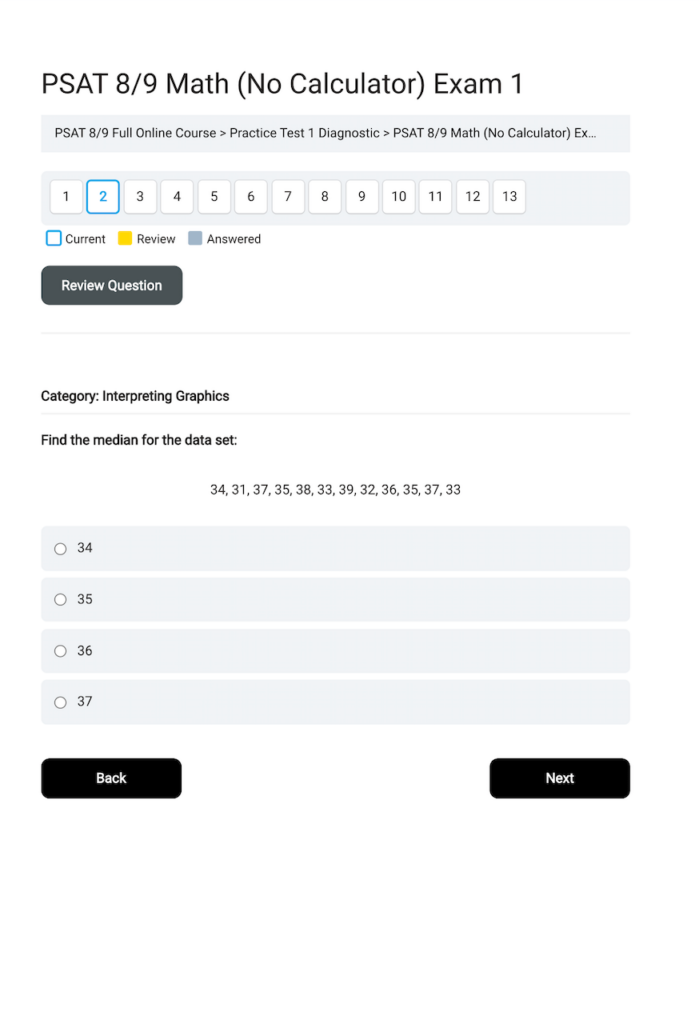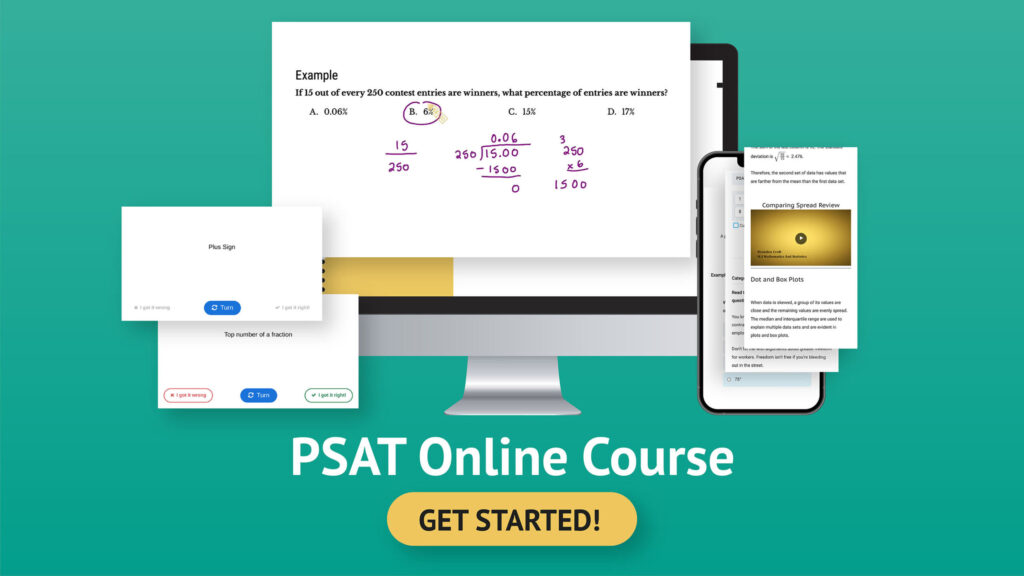PSAT Practice Tests Online
Helpful Tips:
- Taking PSAT 10 practice tests and PSAT 8/9 practice tests can reduce your study time and improve your scores.
- Understand the differences between PSAT 8/9, PSAT 10 and NMSQT.
- Smart Edition Academy has several options if you need more help get started with a free PSAT practice test or prepare with our PSAT 10 online course and PSAT 8/9 online course
PSAT Online Courses
If you want to give your student the best chance for scoring high then the Smart Edition PSAT 8/9 and 10 courses will provide all the material and resources necessary to succeed on the test, including lesson modules, video lessons, timed practice tests, and flashcards.
PSAT 8/9 vs PSAT 10 vs PSAT NMSQT
The PSAT 8/9 and PSAT 10 are a part of the SAT suite. Students can take the PSAT 8/9, PSAT 10, PSAT NMSQT, and then the SAT. The PSAT 8/9 is taken by 8th and 9th graders, while the PSAT 10 is taken by 10th and 11th graders and there is no qualifying scholarship associated with it unlike the NMSQT which does.
The PSAT 8/9 allows for students to create a plan for themselves in preparation for the PSAT 10 or PSAT/NMSQT. The PSAT NMSQT is the closest test to the SAT. If students earn a score in the 99th percentile, they may qualify for scholarships.
Both the PSAT 8/9 and the PSAT 10 and NMSQT have different scoring as well as the length of the tests. The scoring of the PSAT 8/9 ranges from 240 – 1440 while the PSAT 10 and NMSQT ranges higher from 320 – 1520.
Another difference is the potential percentile ranking, the simple reason for this is that more students take the PSAT 10 or PSAT NMSQT than the PSAT 8/9 so in essence it’s harder to get into the top percentiles for PSAT 10 and NMSQT than for PSAT 8/9.
When it comes to question count per subject there are more questions in the PSAT 10 and NMSQT than the PSAT 8/9 with the biggest difference being in math which contains 10 more questions in the PSAT 10 and NMSQT at 48 questions compared to 38 on the PSAT while the time allowed for the test remains the same between the two at 2 hours and 45 mins.
Below is a break down of question counts for each test:
PSAT 8/9 and PSAT 10 Reading
The reading section of the PSAT 8/9 is less complex, you’ll need to be able to make conclusions that are for the most part directly incorporated into the text, it’s just a matter of pulling them out of the text. On the PSAT 10 and NMSQT the questions are a bit more challenging so you’ll have to make more challenging inferences that are not as obvious.
You can also expect to answer questions from graphs but the answers again will be directly included in the graphs. On the PSAT 10 and NMSQT things get a bit more difficult where you might be asked to interpret data trends that take more analysis and are not as straightforward as what you would see on the PSAT 10 and NMSQT.
PSAT 8/9 and PSAT 10 Writing and Language
When it comes to the writing section the PSAT 8/9 is going to be at a lower level of difficulty than the PSAT 10 and NMSQT. For example you’ll see questions testing for punctuation like commas and internal and external punctuation with more simple examples like using commas to separate a series of items while on the PSAT 10 and NMSQT you might be expected to use more complex punctuation like colons and semicolons.
PSAT 8/9 and PSAT 10 Math
The PSAT 8/9 math section will present questions for you to solve that might require less steps to solve than what you will experience on the PSAT 10 and NMSQT. While the topics within the math section may be similar they will generally be less complex and less difficult on the PSAT 8/9.
What is a Good PSAT Score
A good PSAT score is really subjective for each student, especially for the PSAT 8/9 you have to keep in mind that it is intended to predict your future success on subsequent exams like the PSAT 10 and NMSQT and the SAT. The PSAT 8/9 scores range from 240 – 1440 which skews slightly lower than the PSAT 10 and NMSQT.
In general your scores on the PSAT are meant to help identify subjects and topics that you should plan to study more as you move through high school and prepare for the SAT. It’s better to look at your PSAT score as your own personal benchmark for where you stand today and help identify areas where you want to improve on going forward.
A good example of how you might use your PSAT scores is to take a subject like math, if your section score was a 450 you would work towards improving your math skills and would expect to score a 500 or 550 on your PSAT 10 or NMSQT score.
Your PSAT 8/9 score can be used to recommend AP courses that you might consider taking in high school. Taking an AP course will prove to be more difficult than a regular high school course but the reward is that you will push yourself to become more proficient in that subject, positioning you to be more prepared for a test like the SAT. You can read more about PSAT 8/9 scores on the official College Board website.
PSAT Study Tip!
Take advantage of free PSAT practice tests to determine your strengths and weakness so you can get the most out of your studying and PSAT test preparation. Need something more to prepare? Try the Smart Edition Academy PSAT online course.
PSAT Practice Tests Subjects
You will encounter 3 practice test subjects on any practice test you take, those subjects include reading, writing, and math. The best way to prepare for the PSAT is to take a lot of realistic practice tests on each section of the PSAT. A good PSAT practice test should be timed, include questions very similar to the real test, present similar passages, and provide detailed answer explanations to study from.
This PSAT practice test allows for unlimited retakes and gives students a detailed analysis of what areas they need to study in order to score better on their next attempt.
Subjects on the PSAT
There are three subjects on the PSAT: Reading, Language and Writing, and Math.
Language
The language assessment consists of a reading test, as well as a writing test. The reading section will always include approximately four to five passages, depending if there is a “passage pair” used for a set of questions.
These passages always range on a variety of topics to give students breadth in their readings, providing samples of classic literature, historical documents or speeches, and selections pertaining to both social sciences as well as foundational, or common core, sciences.
While none of the passages will require knowledge of science, as it is not a subject that is being assessed, the passages may utilize additional data or references suitable for the student’s grade level and be used for assessment within the question sets.
The questions will all range in a variety of styles, similar to their passages, but consistently staying focused on assessing the student’s ability to utilize the text to draw conclusions about what the text means.
The questions may draw upon specific higher-level vocabulary, the overall style or tone being implemented, or identifying the claims and relationships between author and audiences.
Writing
These same skills will be utilized within the writing section of the test. It’s important to know that unlike the SAT, the PSAT 8/9 does not have an essay portion to the test.
There are many options students can utilize for assessing and building upon the skills needed for the essay requirement on the SAT, however, the PSAT 8/9 will only assess students via the multiple-choice based section of the test.
These questions will require a student’s knowledge on the same various topics within the reading section. However, this section will differ by giving the student samples and asking them to identify the weaknesses within them in order to edit it.
This will require more understanding of English conventions and deeper knowledge of the foundations for writing, without the student needing to provide samples of their own writing.
Math
Opposite the language section of the PSAT 8/9, the test will assess students on their math skills. The math section is also divided into two parts, a non-calculator portion and a calculator portion. *Please note that the calculator a student uses must be considered test appropriate and approved for use by the College Board standards.
The math section will focus on algebra, problem solving, and data analysis. This section will utilize graphs, charts, and other data visualization methods to assess a student’s understanding and solving of complex equations.
While the non-calculator portion will not assess a student on skills as in depth when a calculator is needed, it is important for students to understand how to complete math problems with and without calculators.
The calculator is not meant to substitute understanding, but rather serve a higher purpose of solving for critical thinking.
Simultaneously, it will be up to the student to use their time appropriately when a calculator is available, as not all computations require one. One of the concepts used when designing the math section is the fluency of a student to understand the material and equations in order to properly designate time with a calculator to find a solution.
This concept is reinforced with the grid-in answers that students must provide. Several of the questions, both on the non-calculator and calculator sections, will require students to generate a numerical answer and provide it via a numbers grid-in bubble sheet.
The instructions on how to fill out these bubble sheets will be provided in the test, and may also be viewed on the college board website and within PSAT our online course.
PSAT vs SAT differences
Many students are familiar with the SATs, or Scholastic Aptitude Test. This college entrance exam is famously known for being extremely long, and a rather difficult logic and reasoning skill-based test.
While many options to demonstrate college readiness, the SATs are still widely used for college acceptance.
While the SAT can be a very intimidating exam, the PSAT’s are designed to help students track their progress for taking the SATs.
The Preliminary Scholastic Aptitude Test has been designed to test students on their logic and reasoning skill sets while keeping their educational level in mind. Simply put, they are an easier version of the SATs.
However, it is important to note that “easy” is a general and relative term to describe a standardized test. The level of difficulty of PSAT questions in comparison to SAT questions is easier, simply because it is not practical to test a student’s competency on subject matter that won’t be taught to them until they’ve reached tenth or eleventh grade.
The PSATs keep subject matter consistent with grade levels, so as a result, would be considered just as difficult to the student taking the exam as the SATs would be to a student seeking college acceptance.
There are several differences between the PSAT and SAT.
The first difference is that the PSAT is not considered in the college admissions process and the SAT is. The SAT or ACT is used by colleges to evaluate a student’s application.
On the other hand, the PSAT is used as a practice version of the SAT and is primarily used for students to qualify for certain scholarships.
The second difference between the PSAT and SAT is the scoring system. The biggest difference between the PSAT and the SAT is the scoring scale. The PSAT is scored on a scale of 320-1520, while the SAT is scored on a scale of 400-1600.
The next difference between the PSAT and SAT is their time allotments and number of questions per subtest. The PSAT is 165 minutes and has 139 questions with no essay.
On the other hand, the SAT is 180 minutes and has 155 questions without the optional essay. Students get a similar amount of seconds per question on both the PSAT and SAT. For example, students get 48 seconds per writing question.
Another differentiator between the PSAT and SAT is the essay. There is no essay on the PSAT. The SAT has an optional essay. Colleges typically either require or strongly recommend completing the essay portion of the exam to give applicants an edge.
PSAT 8/9 Online Course
If you want to give your student the best chance for scoring high then the Smart Edition PSAT 8/9 course will provide all the material and resources necessary to succeed on the test, including lesson modules, video lessons, timed practice tests, and flashcards.
Be prepared before taking the test, use PSAT practice tests to measure your strengths, then focus studying on your weaker subjects! See more on PSAT Math Practice test.



